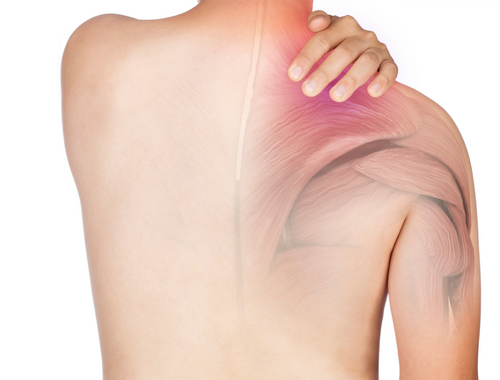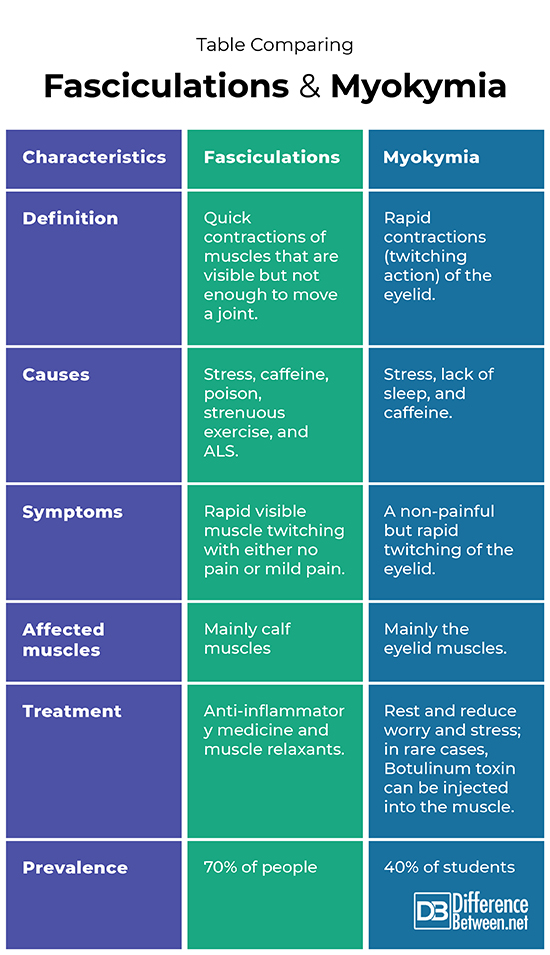Difference Between Fasciculations and Myokymia
Fasciculations are when muscle contractions result in twitches. Myokymia is the twitching of the eyelid.

What is Fasciculations?
Definition:
Fasciculations can be defined as visible and spontaneous muscular contractions that occur but which cannot bring about movement of a limb.
Causes and prevalence:
The causes of fasciculations are many and include stress, physical activity, too much caffeine, and poisons (insecticides). While these are the usual causes of the condition, it can occur also in people who have amyotrophic lateral sclerosis (ALS) and other neurological conditions such as Huntington’s disease and Fabry’s disease. Where the cause of the fasciculations cannot be established, the condition is called benign fasciculation syndrome. Fasciculations are common in older people and occur most often in the calf muscles.
Symptoms:
The symptom of fasciculations is the presence of fast twitching muscles that you can see. The muscle twitching is not enough to move an arm or a leg. Unlike some other muscle contractions (e.g., a Charley horse), fasciculations are not painful, or there is only mild pain. The person may not even notice the muscle twitching, but it is visible when it happens. Other signs may include feeling tired, not wanting to exercise, and stiffness in the afflicted muscle.
Diagnosis:
Diagnosis is based on a physical exam. The doctor will also test your reflexes and may set an appointment for you to have an electromyography. This test, along with neurological assessments and blood work, can help rule out other conditions.
Treatment:
Treating fasciculations usually involves a doctor prescribing muscle relaxants and anti-inflammatory medications. It is also advisable to reduce your stress level since this is a frequent trigger of the condition.

What is Myokymia?
Definition:
Myokymia can be defined as an involuntary twitching of the muscles of the eyelid (usually the lower eyelid).
Causes and prevalence:
Myokymia can be a result of stress and anxiety. Exhaustion and insufficient sleep can also cause the condition. People with Multiple Sclerosis sometimes get myokymia. A magnesium deficiency and certain drugs can also cause the condition, and so can dry eyes and air-borne irritants like smoke. Myokymia is common in medical students, where stress is often high.
Symptoms:
The symptom of myokymia is a contraction of the eyelid. This is a small continual contraction that most commonly occurs on the lower eyelid. The contracting muscle is usually only on one eyelid and may happen for a few seconds to several hours.
Diagnosis:
The condition can be diagnosed by a physical exam noting the symptoms. Taking a patient’s history is important as well in finding out if there are stressful events in the patient’s life.
Treatment:
For most patients, all that is needed is to rest and decrease stress and worry. Cutting back on caffeine can also be helpful. Where myokymia is persistent, Botulinum toxin injections can be helpful. However, this is rarely needed.
Difference between Fasciculations and Myokymia?
Definition
Fasciculations are when there are fast contractions of the muscles, which, although visible, are not powerful enough to move a joint. Myokymia is a rapid twitching contraction of the muscles of the eyelid.
Causes
Stress, caffeine, poison, strenuous exercise, and ALS are causes of fasciculations. Stress and too much caffeine are the commonest causes of myokymia.
Symptoms
The sign you have fasciculations is that you have rapid, visible muscle twitching with either no pain or mild pain. The sign you have myokymia is your eyelid twitches, but there is no pain.
Affected muscles
The calf muscles are most often affected by fasciculations. The eyelid muscles are affected by myokymia.
Treatment
Anti-inflammatory medicine and muscle relaxants are the way to treat fasciculations. Eyelid twitches (myokymia) don’t usually require any treatment, but in severe cases, Botulinum toxin injections can help.
Prevalence
Fasciculations occur in about 70% of all people. Myokymia is common in students, occurring in 40% of medical students.
Table comparing Fasciculations and Myokymia

Summary of Fasciculations Vs. Myokymia
- Both fasciculations and myokymia involve contracting muscles.
- Myokymia is specific to the face, and most particularly, the lower eyelid on one side of the face.
- Fasciculations are not normally very painful, but the muscle contractions are visible.
- Both myokymia and fasciculations can be due to stress and caffeine, but only fasciculations may also be due to neurological diseases.
FAQ
Are twitches and fasciculations the same thing?
Yes, twitches and fasciculations of muscles are often viewed as the same thing by many people, with twitches being a general term that is used to describe rapid muscular contractions.
What is the difference between fasciculations and myoclonus?
Fasciculations are short-lived muscle twitches that are not strong enough to bring about any motion around a joint. Myoclonus is a jerking motion that does enable movement around a joint.
Is myokymia a symptom of ALS?
Myokymia is not usually a symptom of ALS and only rarely if ever, occurs in such patients.
Are fasciculations always ALS?
Fasciculations can indicate ALS, but not always, as there are many other causes, including magnesium deficiency or caffeine.
What neurological conditions cause fasciculations?
Several neurological conditions can result in fasciculations; these include, for instance, Huntington’s disease, Fabry’s disease, Gerstmann-Sträussler disease, and motor neuron disease.
Do fasciculations come first in ALS?
No, the earliest symptoms of ALS are weak and stiff muscles.
- Difference Between Rumination and Regurgitation - June 13, 2024
- Difference Between Pyelectasis and Hydronephrosis - June 4, 2024
- Difference Between Cellulitis and Erysipelas - June 1, 2024
Search DifferenceBetween.net :
Leave a Response
References :
[0]Finsterer, Josef, and Rahim Aliyev. "Fasciculations in human hereditary disease." Acta Neurologica Belgica 115.2 (2015): 91-95.
[1]Newman, George. “How to assess the motor system”. Merckmanuals. Merck & Co., 2020, https://www.msdmanuals.com/professional/neurologic-disorders/neurologic-examination/how-to-assess-the-motor-system
[2]Patel, Bhupendra C. "Eyelid Myokymia." StatPearls [Internet]. StatPearls Publishing, 2021. https://www.ncbi.nlm.nih.gov/books/NBK560595/
